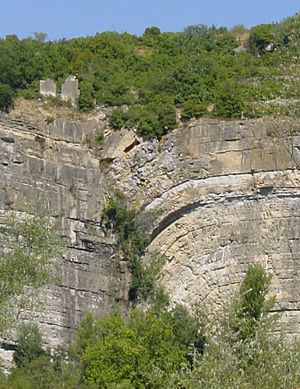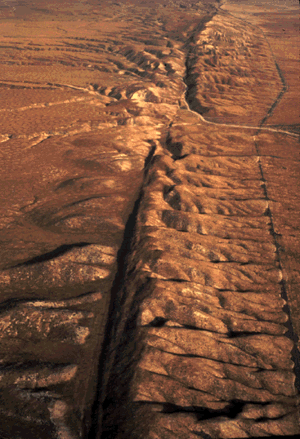Fault (geology) facts for kids
A fault is a big crack or break in the Earth's outer layer, called the crust. Think of the Earth's crust like a giant puzzle. When pieces of this puzzle crack and move, that's a fault!

Red rock = Triassic mudstone
Blue-grey rock = latest Triassic to earliest Jurassic
The line of the fault runs along the beach, shown by the rock / sand divide
When a fault is active, the huge blocks of rock on either side of the crack can slowly slide past each other. This movement is what often causes earthquakes.
The actual surface where the rocks slide is called the fault plane. If this plane reaches the Earth's surface, it can create a steep cliff or slope. This is called a fault scarp.
The way a fault slopes is called its dip angle. Some faults are nearly flat, while others are very steep.
Contents
Types of Faults
Scientists put faults into three main groups based on how the rock blocks move.
Normal Faults
A normal fault happens when the Earth's crust is being pulled apart. Imagine stretching a piece of dough. When it breaks, one side drops down compared to the other.
- In a normal fault, the block of rock above the fault plane (called the "hanging wall") moves down relative to the block below it (the "footwall").
- These faults are common in places where the Earth's crust is stretching and thinning.
- Good examples are the Mid-Ocean Ridges (where new ocean floor is made) and the African Rift in Africa.
Reverse and Thrust Faults

These faults happen when the Earth's crust is being pushed together, or squeezed. Imagine pushing two ends of a rug together; it will wrinkle up and overlap.
- In a reverse fault, the block of rock above the fault plane (the "hanging wall") moves up relative to the block below it (the "footwall").
- If the fault plane is not very steep (it's almost flat), it's called a thrust fault.
- These faults make the Earth's crust shorter and thicker.
- They are often found where continents are colliding, like when mountains are forming.
Strike-Slip Faults
A strike-slip fault is different because the blocks of rock slide past each other horizontally, not up or down. Imagine two cars driving past each other on a road.
- The fault plane for these faults is usually straight up and down (vertical).
- Famous examples include the San Andreas Fault in California, which caused the huge 1906 San Francisco earthquake.
- Another well-known one is the Alpine Fault in New Zealand.

Images for kids
-
Satellite image of a fault in the Taklamakan Desert. The two colorful ridges (at bottom left and top right) used to form a single continuous line, but have been split apart by movement along the fault.
-
Normal fault in La Herradura Formation, Morro Solar, Peru. The light layer of rock shows the displacement. A second normal fault is at the right.
-
A fault in Morocco. The fault plane is the steeply leftward-dipping line in the centre of the photo, which is the plane along which the rock layers to the left have slipped downwards, relative to the layers to the right of the fault.
-
Inactive fault from Sudbury to Sault Ste. Marie, Northern Ontario, Canada
See also
 In Spanish: Falla para niños
In Spanish: Falla para niños











